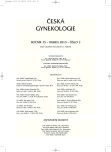Current possibilities for diagnosis of vulvovaginal infection
Authors:
J. Mašata 1; A. Jedličková 2; M. Poislová 2; D. Mašátová 2; A. Martan 1
Authors‘ workplace:
Gynekologicko-porodnická klinika VFN a 1. LF UK, Praha, přednosta prof. MUDr. A. Martan, DrSc.
1; ÚKBLD, Klinická mikrobiologie a antibiotické centrum VFN a 1. LF. UK, Praha, přednosta prof. MUDR. T. Zima, DrSc.
2
Published in:
Ceska Gynekol 2010; 75(2): 111-117
Overview
Objective of the study:
The objective of the study was to describe current possibilities of proper diagnosis of vulvovaginal infections.
Design:
Review article.
Settings:
Department of Gynecology and Obstetrics, First Medical Faculty, Charles University and the General Teaching Hospital, Prague, Institute of Clinical Chemistry and Laboratory Medicine, Clinical microbiology and antibiotic center, First Medical Faculty, Charles University and General Teaching Hospital in Prague.
Material and methods:
Presentation of literature review information and our practical skills in diagnosing vulvovaginal infections.
Conclusions:
Vulvovaginal infections are a common problem which we encounter in daily gynaecological practice. Most women with those conditions need only basic investigation and treatment. However, in order to offer the appropriate care for those women it is necessary to understand the basic pathophysiology of vulvovaginal disorders. A fundamental step is to make the correct diagnosis. All too often our decisions are influenced by clinical dogmas which are even found repeatedly in gynaecological textbooks. Microscopic examination represents the gold standard in the diagnosis of vulvovaginal infections.
Key words:
vulvovaginal infections, gram stain, bacterial vaginosis, aerobic vaginitis, candida vulvovaginitis, trichomonas vaginalis infection.
Sources
1. Amsel, R., Totten, P., Spiegel, C., et al. Nonspecific vaginitis. Diagnostic criteria and microbial and epidemiologic associations. Am J Med 1983, 74, 1, p. 14-22.
2. Babula, O., Lazdane, G., Kroica, J., et al. Relation between recurrent vulvovaginal candidiasis, vaginal concentrations of mannose-binding lectin, and a mannose-binding lectin gene polymorphism in Latvian women. Clin Infect Dis 2003, 37, 5, p. 733-737.
3. CDC. CDC, Sexually transmitted diseases. Treatment guidelines. 2002, 51, RR-6, p. 1-80.
4. Donders, G., Vereecken, A., Salembier, G., et al. Assessment of vaginal lactobacillary flora in wet mount and fresh or delayed Gram’s stain. Infect Dis Obstet Gynecol 1996, 4, 1, p. 2-6.
5. Donders, G., Vereecken, A., Bosmans, E., et al. Definition of a type of abnormal vaginal flora that is distinct from bacterial vaginosis: aerobic vaginitis. BJOG 2002, 109, 1, p. 34-43.
6. Donders, GG., Vereecken, A., Dekeersmaecker, A., et al. Wet mount microscopy reflects functional vaginal lactobacillary flora better than Gram stain. J Clin Pathol 2000, 53, 4, p. 308-313.
7. Ferris, D., Dekle, C., Litaker, M. Women’s use of over-the-counter antifungal medications for gynecologic symptoms. J Fam Pract 1996, 42, 6, p. 595-600.
8. Ferris, M., Masztal, A., Aldridge, K., et al. Association of Atopobium vaginae, a recently described metronidazole resistant anaerobe, with bacterial vaginosis. BMC Infect Dis 2004, 4, 5.
9. Friedrich, E. The vulvar vestibule. J Reprod Med 1983, 28, 11, p. 773-777.
10. Giraldo, P., von Nowaskonski, A., Gomes, FA., et al. Vaginal colonization by Candida in asymptomatic women with and without a history of recurrent vulvovaginal candidiasis. Obstet Gynecol 2000, 95, 3, p. 413-416.
11. Horowitz, B., Mardh, P., Nagy, E., et al. Vaginal lactobacillosis. Am J Obstet Gynecol 1994, 170, 3, p. 857-861.
12. Hugenholtz, P., Goebel, BM., Pace, NR. Impact of culture-independent studies on the emerging phylogenetic view of bacterial diversity. J Bacteriol 1998, 180, 18, p. 4765-4774.
13. Jeremias, J., Ledger, W., Witkin, S. Interleukin 1 receptor antagonist gene polymorphism in women with vulvar vestibulitis. Am J Obstet Gynecol 2000, 182, 2, p. 283-285.
14. Ledger, W., Polaneczky, M., Yih, M., et al. Difficulties in the diagnosis of Candida vaginitis. Infect Dis Clin Pract 2000, 9, 4, p. 66-69.
15. Ledger, W., Monif, G. A growing concern: inability to diagnose vulvovaginal infections correctly. Obstet Gynecol 2004, 103, 4, p. 782-784.
16. Ledger, W., Witkin, S. Vulvovaginal infections. London: Manson Publishing 2007, p. 128.
17. Mašata, J., Jedličková, A., et. al. Infekce v gynekologii a porodnictví. Praha: Maxdorf 2004, s. 371.
18. Nugent, RP., Krohn, MA., Hillier, SL. Reliability of diagnosing bacterial vaginosis is improved by a standardized method of gram stain interpretation. J Clin Microbiol 1991, 29, 2, p. 297-301.
19. Ross, R., Lee, M., Onderdonk, A. Effect of Candida albicans infection and clotrimazole treatment on vaginal microflora in vitro. Obstet Gynecol 1995, 86, 6, p. 925-930.
20. Schwebke, J., Hillier, S., Sobel, J., et al. Validity of the vaginal Gram stain for the diagnosis of bacterial vaginosis. Obstet Gynecol 1996, 88, 4 Pt 1, p. 573-576.
21. Solomon, D., Davey, D., Kurman, R., et al. The 2001 Bethesda System: Terminology for Reporting Results of Cervical Cytology. JAMA 2002, 287, 16, p. 2114-2119.
22. Spiegel, CA., Amsel, R., Holmes, KK. Diagnosis of bacterial vaginosis by direct Gram stain of vaginal fluid. J Clin Microbiol 1983, 18, 1, p. 170-177.
23. Witkin, SS., Jeremias, J., Toth, M., et al. Detection of Chlamydia trachomatis by the polymerase chain reaction in the cervices of women with acute salpingitis. Am J Obstet Gynecol 1993, 168, 5, p. 1438-1442.
24. Zhou, X., Bent, SJ., Schneider, MG., et al. Characterization of vaginal microbial communities in adult healthy women using cultivation-independent methods. Microbiology 2004, 150, 8, p. 2565-2573.
Labels
Paediatric gynaecology Gynaecology and obstetrics Reproduction medicineArticle was published in
Czech Gynaecology

2010 Issue 2
Most read in this issue
- Current possibilities for diagnosis of vulvovaginal infection
- Significance of hysteroscopic resection in diagnostics of endometrial cancer
- Recommendation for hormone replacement therapy in postmenopause
- New Single-Incision Sling System MiniArc in treatment of the female stress urinary incontinence
